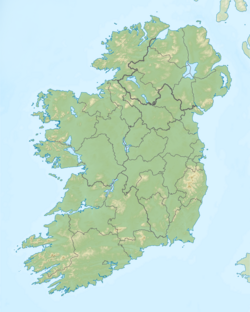
An Leabhar Breac
| An Leabhar Breac | |
|---|---|
| Royal Irish Academy | |
| Also known as | Speckled Book, Great Book of Dun Doighre |
| Type | Compilation of Irish legends |
| Date | 1408–1411 |
| Place of origin | Duniry |
| Language(s) | Middle Irish and Latin |
| Scribe(s) | Murchadh Ó Cuindlis |
| Material | Vellum |
| Size | 40.5 cm × 28 cm (16 in × 11 in) |
| Format | Folio |
| Script | Irish minuscule |
An Leabhar Breac ('The Speckled Book'; Middle Irish: An Lebar Brec[1][2]), now less commonly Leabhar Mór Dúna Doighre ('Great Book of Dun Doighre') or possibly erroneously, Leabhar Breac Mic Aodhagáin ('The Speckled Book of the MacEgans'),[3] is a medieval Irish vellum manuscript containing Middle Irish and Hiberno-Latin writings. The manuscript is held in the library of the Royal Irish Academy in Dublin, where it is catalogued as RIA MS 23 P 16 or 1230.

It was most probably compiled by Murchadh Riabhach Ó Cuindlis (of Ballaghdacker, Athleague) at Duniry between the years 1408 and 1411.[4][5] Duniry – Dún Daighre, Dún Doighre – in eastern Clanricarde (now east County Galway) is situated south-east of the town of Loughrea, and in the medieval era was home to a branch of the bardic Clann Mac Aodhagáin (the MacEgans), who served as brehons for the O'Connors of Clanricarde.

History
In the 16th century, the manuscript was in the possession of the Mac Egans of Duniry, hence the older title Leabhar Mór Dúna Doighre. In 1629, the manuscript was held in the convent of Kinalehin, County Galway.

It was consulted by Mícheál Ó Cléirigh, brother of the Four Masters, who copied pages 272–277. The book passed into the possession of Éamon Ó Ceallaigh (County Roscommon) in 1732, then of John O'Brien by 1768, and finally of Conchubhar (Bán) Ó Dála (Conchúr Bán Ó Dálaigh or Cornelius O'Daly) (Mitchelstown, County Cork). The Royal Irish Academy acquired the first volume in 1789 when General Charles Vallancey purchased it for the academy for three guineas from Cornelius O'Daly. O'Daly also owned the second volume, which comprises nine leaves, but was unaware that it belonged to the larger volume. In 1789, this volume was acquired by Chevalier O'Gorman, by George Smith of College Green in the next century, and by the academy sometime after 1844. The manuscript is held in the academy's library in Dublin to this day.[6]

Description
The manuscript is of a large size, measuring 40.5 cm x 28 cm, which makes it the largest Irish vellum manuscript to have been written by a single scribe.[7] It contains 40 folios, which are written in double columns. Capitals are decorated in a simple style, with some letters having been interwoven with zoomorphic patterns and coloured in red, vermilion, yellow and blue. There are two drawings, a flower-like diagram on p. 121 and a drawing of the Crucifixion on p. 166.[8]

Contents
The manuscript consists almost entirely of religious writings in Latin and Middle Irish. It includes homiletic Lives of Saint Patrick, Saint Columba, Saint Brigid, Saint Cellach, and Saint Martin, the earliest version of Félire Óengusso ('Martyrology of Óengus'), the Rule of the Céli Dé, Aislinge Meic Con Glinne ('Vision of Mac Conglinne'), a version of Fís Adamnáin ('Vision of Adamnán'), Saltair na Rann, Stair Nicomeid ('Gospel of Nicodemus'), Amra Choluim Chille, a Marian litany, and various ecclesiastical legends, hymns, catecheses, and homilies. Exceptions to the predominantly religious contents are Sanas Cormaic ('Cormac's Glossary') and a history of Philip of Macedon and Alexander the Great.[9]

Glosses and notes
The numerous notes which Murchadh Ó Cuindlis jotted into the margins afford us a unique glimpse of the circumstances of the writing process. These range from everyday details like a cat straying about or a robin singing in a beautiful voice to a nearby pillage in Lorrha by a certain Murchad Ua Madagáin. A persistent object of complaint for the writer is the weather, in particular the cold.[10] Based on the notes, Tomás Ó Con Cheanainn has been able to reconstruct the time span in which certain sections were written. For instance, it took the scribe about 6 weeks to write 35 pages (pp. 141–175), while some parts proved more challenging, such as a column for a poem with interlinear glosses, which cost him a day.[10]

See also
References
- ^ "Mac Carthy 1892a/Toc01". CODECS: Online Database and e-Resources for Celtic Studies.
- ^ Doležalová, Lucie (17 November 2009). The Making of Memory in the Middle Ages. ISBN 9789047441601.
- ^ Leabhar Breac Mic Aodhagáin is also the title of a book cited by Geoffrey Keating in Book III of Foras Feasa ar Éirinn, described as an 'old book of annals' (seinleabhar annálach) and probably now lost. Irish Script on Screen.
- ^ Holohan, Frances. "The Leabhar Breac – Reproduced in 1876: Shining a Light on the Original Ancient Manuscript". Abbey and District Heritage. Galway County Council Heritage Office / National Museum of Ireland. Retrieved 9 October 2023. Citing: Ó Conaill, Mícheál (1932). Cineál Fhéichín agus Síol Anmcha. And: Ó Con Cheanainn, Tomás (1973). "The scribe of the Leabhar Breac". Ériu. 24. Dublin: Royal Irish Academy: 64–79. ISSN 0332-0758. Also quotes at some length from an unspecified publication of Nollaig Ó Muraíle.
- ^ Welch, Robert (2000). The Concise Oxford Companion to Irish Literature. Oxford University Press. p. 191. ISBN 9780192800800.
- ^ Irish Script on Screen.
- ^ Royal Irish Academy, "Leabhar Breac" Archived November 18, 2008, at the Wayback Machine
- ^ See the images at ISOS.
- ^ Peters, E. (ed. and tr.). "Die irische Alexandersage". Zeitschrift für celtische Philologie 30 (1967): 71–264.
- ^ a b O'Neill, "Leabhar Breac" (2004).
Sources
- Atkinson, Robert (ed. and tr.). The Passions and the Homilies from Leabhar Breac: Text, Translation, and Glossary. Todd Lecture Series II. Dublin, 1887. Edited text available online from CELT.
- Ó Longáin, Joseph (fasc.); Gilbert, J. J. (ed.). Leabhar Breac, the Speckled Book, otherwise styled Leabhar Mór Dúna Doighre, the Great Book of Dun Doighre. Dublin, 1876. Lithographic facsimile edition.[1]
- O'Neill, Timothy. "Leabhar Breac". In Medieval Ireland. An Encyclopedia, ed. Seán Duffy. New York, 2004. pp. 266–267.
- Greene, David and Frank O’Connor (eds. & trs.). A Golden Treasury of Irish poetry, A.D. 600 to 1200. London: Macmillan, 1967.
- Gwynn, Edward J. (ed.); "Rule of the Céli Dé" (9b-12b). In The Rule of Tallaght. Hermathena 44, 2nd Supplement. 1927.
- Stokes, Whitley (ed. & tr.); "Betha Phatraic: Life of St Patrick" (Leabhar Breac pp. 24b-29b). Three Middle-Irish Homilies. Calcutta, 1877. Text edition and translation available online from CELT.
- Welsh, Robert. Oxford Concise Companion to Irish Literature. 1996. ISBN 0-19-280080-9
- "Irish Script on Screen" (Dublin Institute for Advanced Studies): images and description of Leabhar Breac.
Further reading
- Bernard, J. H. "On the citations from scripture in the Leabhar Breac". Transactions of the Royal Irish Academy 30 (1893): 321–4.
- Egan, J. J.; Egan, M. J. History of Clan Egan: The birds of the forest of wisdom. Ann Arbor, 1979. 59–67.
- Mulchrone, Kathleen; et al. Catalogue of Irish manuscripts in the Royal Irish Academy. Dublin, 1943. Fasc. 27.
- Ó Con Cheanainn, Tomás. "The scribe of the Leabhar Breac". Ériu 24 (1973): 64–79.
- Ritmueller, J. "The Hiberno-Latin Background of the Leabhar Breac Homily "In Cena Domini". Proceedings of the Harvard Celtic Colloquium 2 (1982): 1–10.
- Haubrichs, Wolfgang. "Die altlateinische Gallicanus-version (Gall.) der Georgslegende und ihr Reflex im Leabhar Breac." In Ireland and Europe in the early Middle Ages. Texts and transmission / Irland und Europa im früheren Mittelalter. Texte und Überlieferung, ed. Próinséas Ní Chatháin and Michael Richter. Dublin: Four Courts, 2002. 170–185.
External links
- Scéla. Catalogue of medieval Irish narratives & literary enumerations
- The Lebar Brecc Tractate on the Canonical Hours, ed. R. I. Best.
- Regula Mochuta Rathin, ed. Kuno Meyer.
- The Mothers’ Lament at the Slaughter of the Innocents, ed. Kuno Meyer.
- Imchlód Aingel (Aingil Dé dom dín), ed. T. P. O'Nolan.
- Die Kreuzeslegenden im Leabhar Breac - Inaugural-Dissertation zur Erlangung de Doctorwuerde (in German) by Gustav Schirmer, St. Gallen, 1886
- ^ "Leabhar Breac, the Speckled Book ; otherwise styled Leabhar Mór Dúna Doighre, the Great Book of Dún Doighre : A collection of pieces in Irish and Latin, compiled from ancient sources about the close of the fourteenth century: Now for the first time published from the original manuscript in the library of the Royal Irish Academy". Dublin : Royal Irish Academy. 1872.
See what we do next...
OR
By submitting your email or phone number, you're giving mschf permission to send you email and/or recurring marketing texts. Data rates may apply. Text stop to cancel, help for help.
Success: You're subscribed now !

